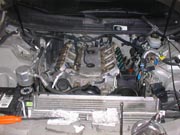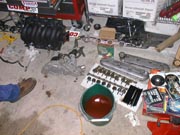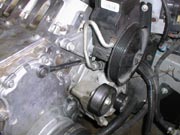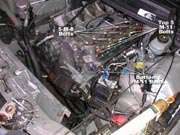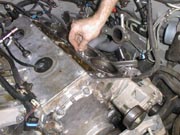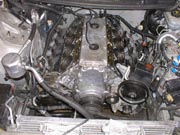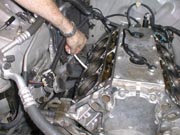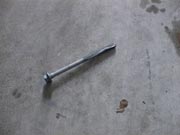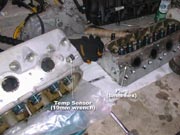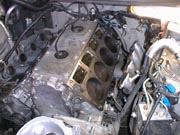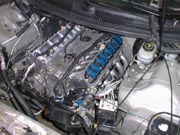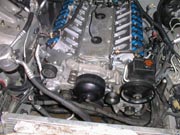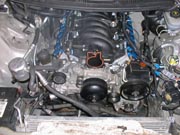LS1 Head Swap
E-mail jmX with corrections
Click here for a printable version
| Tools Needed: |
- Set of metric sockets, deep and normal - Metric box wrenches - Metric "Gear" wrenches (not absolutly nessisary, but REALLY handy) - Stubby 15mm open ended wrench - 19mm box wrench - 8mm allen wrench - Torque wrench for 20ft/lbs up to 100+ft/lbs - Various socket extensions, ranging from 3" to 12" - Medium length socket wrench - Large 1/2" drive socket wrench - 15mm 1/2" drive socket, plus 3" and 6" 1/2" extension - Shop rags, roll of paper towels - Felt tipped marker - Plastic ice scraper (for windsheilds) - air compressor with air sprayer nozzle - standard wrenches for exhaust bolts (size depends on headers/ypipe) |
| Parts you will need: |
- 16 Long "M-11" Headbolts PN 12560744 - 4 Short "M-11" Headbolts PN 12560745 - 10 "M-8" Headbolts PN 12558840 (PN might be for bag of 5) - 2 Head gaskets PN 12558809(drivers side) and 12558810 (pass side) - 2 AIR tube gaskets PN 12553617 - 1 EGR gasket PN 12553047 - 6 quarts of oil, new filter - Water pump gaskets for 1998 model cars (PN 12559271 2 needed) - Jug of dexcool compatible coolant (or save your old stuff) |
| NOTES: |
|
A very common mod these days is to swap on ported heads. We went with heads from ARE and the heads came with the springs/valves pre-installed for our convienience...your heads will probably come the same way. Here are a few shots showing the difference between stock heads and the ported heads: |
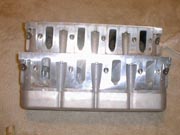 Intake port comparison |
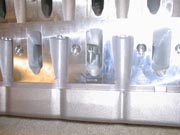 Ported intake ports |
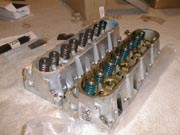 Kmotion (left) vs Hotcam springs |
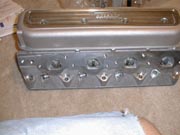 C5R valve covers with ARE logo |
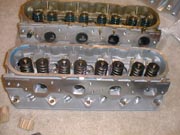 Exhaust port comparison |
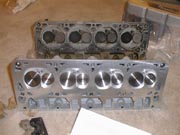 Valve comparison |
Lets begin:
|
Preliminary stuff:Disconnect the negative terminal on the battery and then start draining the radiator by opening the valve on the bottom passenger side of the radiator. Remove the air lid/MAF assembly. Disconnect the throttle cable and possibly the cruise control cable from your throttle body.
Remove the Intake manifold using the instructions I provide here. You can leave the fuel rail and throttle body connected to the intake manifold. Remove the coolant pipe(s) shown in the link as well and place them aside. Remove the AIR tubes by unbolting the air tubes from the exhaust manifolds/headers. There are 2 10mm bolts holding the tubes down. Once unbolted, unhook the tubes from the rubber hoses they are attached to. Use a screwdriver to pry off the plastic fastener. Remove the EGR valve by unbolting the 2 15 mm bolts holding it to the passenger side head. Then unbolt the 2 10mm bolts from the exhaust manifold/header and disconnect the electronics going to the EGR. Place assembly aside. Remove the coil packs by first disconnecting the plug wires, then unplugging the big plastic wiring harness, then unbolting the 5 double ended bolts holding the pack rail to the valve cover ('98 cars will have to remove each pack individualy). These bolts are 10mm and you'll need a deep socket to get to them. DO NOT loosen the "pointy" looking double ended bolts. The rear one on the passenger side is a real PITA....I never reinstalled mine after the first time I took it off...you shouldnt either. Remove the valve covers using an 8mm socket to undo the 4 bolts holing it to the head. Once loosened, pull the bolts up a bit...they wont come all the way out. Once loosened, pull the valve cover off. You'll need to unplug the PVC vent hoses from the backs of the valve covers...they will just pull right out. Take off Ypipe by unbolting the 2 bolts on the flange at the bottom of the headers. Our bolts were 9/16". Loosen the ypipe where it connects to the catback exhaust until you can get the ypipe free from the headers. Once free, remove the 12 bolts (6 on each side) holding the exhaust manifolds or headers to the head. |
| OPTIONAL CAM SWAP: |
|
Now, if you want to do a cam swap, this is the time. Unbolt the plastic pushrod guides from the block and the lifter should come out with them. Set them aside keeping them in the exact same order you pulled them out. Pull the crank pulley, unbolt the timing chain cover, unbolt the cam gear, unbolt the cam retainer plate, then pull out the cam and slide the new one in. For more details on a camswap you can read MBasketts site here: www.torquecentral.com Note that you wont have to follow his instructions exactly since the heads will already have the springs installed and there is NO danger of lifters falling since the heads are off. A cam swap would literally take less than an hour at this point :) Now back to the headswap..... |
| Final thoughts: |
| Well, I've done a headswap 4 times now and each time I was amazed at how easy this job actually is. There are no tricky parts, and the only part that takes effort is cleaning the bolt holes and torquing the heads down right. If you are handy with tools and have everything listed above, this swap should be a piece of cake. |



